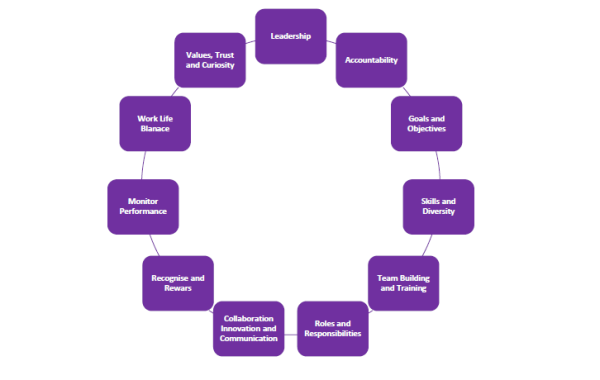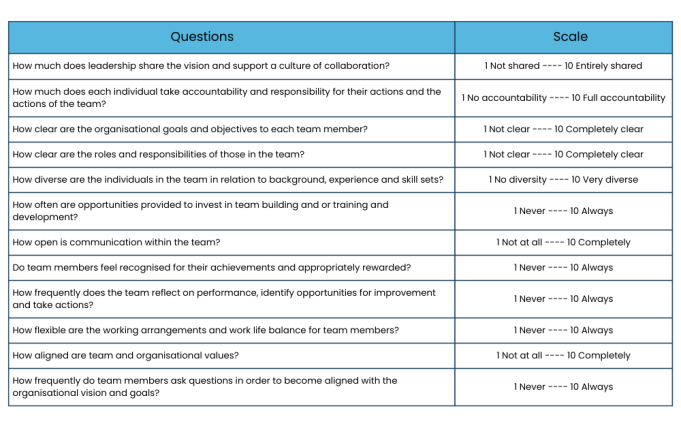The Secrets of High Performing Teams

We all want to be part of a high performing team, and organisations are looking to create the elusive environment where high performing teams are the norm. So, what does a high performing team look like and what behaviours should we expect to see?
- Active Participation in Meetings: In high-performing teams, all members actively contribute by sharing ideas, asking questions, and offering suggestions. They engage in constructive, open passionate discussions, listen attentively to others, and actively participate in decision-making processes whilst ensuring that all voices are heard.
- Prompt Response to Requests: Team members respond promptly to requests for assistance, information, or feedback. They demonstrate a sense of urgency and prioritise tasks to ensure that deadlines are met and expectations are fulfilled in a timely manner or advise quickly when deadlines are unable to be met due to circumstances outside the team’s control.
- Willingness to Take on Challenges: High-performing teams are not afraid to tackle difficult tasks or pursue ambitious goals. Team members volunteer to take on challenging assignments, stretch themselves outside their comfort zones, and embrace opportunities for growth and development. They also do so with a willingness to fail and learn and accept that success may simply be the learning that is achieved, rather than the original expectation.
- Proactive Problem-Solving: When faced with obstacles or setbacks, high-performing teams approach problems with a proactive and solution-oriented mindset. They brainstorm creative solutions, analyse root causes, and collaborate to develop and implement action plans to overcome challenges effectively. They recognise that failure is normal, and the learning achieved during the process is often more powerful than a pretended achievement of success.
- Constructive Feedback: Team members provide and receive feedback in a constructive and respectful manner. They offer specific, actionable feedback aimed at helping their colleagues improve performance or achieve goals using tools such as Situation, Behaviour Impact (SBI). Feedback is focused on behaviours and outcomes rather than personal characteristics. Permission is asked before providing feedback and providing positive feedback is the norm.
- Supportive Environment: High-performing teams create a supportive and inclusive environment where all members feel valued, respected, and empowered to contribute. Team members offer encouragement, praise each other's achievements, and provide emotional support during challenging times. Team members are able to bring their full selves to the team and have a sense of belonging and joint purpose.
- Shared Responsibility for Success and Failure: Team members share a collective sense of responsibility for the team's success and failure. They celebrate achievements together and take accountability for mistakes or setbacks, focusing on learning and improvement rather than assigning blame. Failure is considered normal and an opportunity for learning.
- Cross Functional Collaboration: High-performing teams collaborate across functional boundaries, leveraging the diverse skills and expertise of team members from different departments or disciplines. They break down silos, share knowledge and resources, and work together to achieve common goals.
They focus on organisational success, even when this might not be the most beneficial for the individual teams. - Adaptability to Change: In dynamic environments, high-performing teams demonstrate adaptability and resilience. They embrace change, quickly adjust to shifting priorities or circumstances, and proactively seek opportunities to innovate and improve. They recognise that change is not only normal but unavoidable and that whilst planning is essential, one must never simply blindly follow that plan.
- Continuous Learning and Development: Team members are committed to their own learning and development as well as that of their colleagues. They seek out opportunities for training, attend workshops or seminars, and share good practices and lessons learned with their team members to enhance collective capabilities. They encourage each other to participate in their corporate and professional communities and support each other when they do so.
Now that we understand how a high performing team acts, we will consider how to create and sustain High Performing Teams.

- Effective Leadership: Strong leadership is critical for guiding and empowering high performing teams. Effective leaders provide vision, support, and direction while fostering a culture of collaboration, innovation, and continuous improvement. Leaders must be story tellers who bring the vision to the whole team and ensure everyone is aligned.
- Accountability and Responsibilities: Each team member should take ownership of their responsibilities and be accountable for their contributions to the team's success. A culture of accountability fosters commitment and ensures that tasks are completed on time and to a high standard. This is particularly true for leaders who need to demonstrate that they will hold themselves accountable and demonstrate this to their team.
- Clear Goals and Objectives: High-performing teams have a shared understanding of their goals and objectives. Clear direction enables team members to align their efforts and work towards common objectives. The leader is story-teller to align the team around the goals and objectives of the organisation or initiative at hand.
- Establish Clear Roles and Responsibilities: Define clear roles, responsibilities, and expectations for each team member to minimise confusion and ensure accountability. Clarify how individuals contribute to the team's overall success. Ensure the roles of the leadership team are very clear and transparent.
- Complementary Skills and Diversity: High-performing teams consist of individuals with diverse backgrounds, experiences, and skill sets. By leveraging the strengths of each team member, the team can tackle complex problems and adapt to changing circumstances more effectively. This means not only diversity of gender, race and religion but encompasses differences in age, background, geography, abilities, and neurodiversity.
- Invest in Team Building and Training and Development: Organise team-building activities, workshops, and retreats to foster relationships, build trust, and improve communication among team members. Most importantly, ask the team for input into what activities they would like to participate in. No-one wants to go along to a prescribed team building event that they aren’t interested in. Offer training programs and professional development opportunities to enhance team members' skills, knowledge, and capabilities. Continuous learning promotes growth and keeps the team's skills up-to-date. Again, work with team members to ensure the opportunities are aligned with their needs.
- Encourage Collaboration and Innovation with open communication: A team is a cohesive unit of professionals focused on an objective. To achieve the objective a team needs to understand the problem, validate assumptions and gather feedback and data. It is vital to create a collaborative environment where team members are encouraged to share ideas, experiment with new approaches, and challenge the status quo. Foster a culture of
innovation by rewarding creativity and risk-taking. Encourage team members to think beyond their zone of interest and explore different approaches with curiosity. Create and environment where psychological safety is the standard for the team and leadership. Open and transparent communication is essential for collaboration within high-performing teams. Team members should feel comfortable sharing ideas, providing feedback, and resolving conflicts constructively. Establish channels for open and honest communication, such as regular team meetings, feedback sessions, and anonymous suggestion boxes. Encourage constructive feedback and active listening to address issues and improve team dynamics. More importantly, show team members how this open communication leads to change and success. - Recognise and Reward Achievement: Acknowledge and celebrate the achievements and contributions of individual team members and the team as a whole. Recognition reinforces positive behaviour and motivates team members to continue performing at a high level. Even small recognition at a team level is valuable such as a chocolate frog award or simply acknowledging a team member in a team meeting promote a culture of recognition. Be aware however, to respect team member boundaries. Some people do not like to be
called out publicly for their contribution. Get to know your team and what resonates with them. - Monitor and Adjust Performance: Regularly assess the team's performance, identify areas for improvement, and implement corrective actions as needed. Monitor key performance indicators (KPIs) to track progress towards goals and adjust strategies accordingly. This is especially true of leadership. Be transparent about improvements being made at a leadership level and learn from mistakes.
- Promote Work-Life Balance: Support work-life balance by offering flexible work arrangements, promoting wellness initiatives, and encouraging time off to recharge. A healthy work-life balance contributes to employee satisfaction, morale, and productivity. Some organisations provide a day off for birthdays which is a lovely way to recognise team members or even simply to log off or go home early when something of personal significance is taking place such as Diwali, Ramadan or parent teacher interviews.
- Shared Values and Trust: Trust is the foundation of high-performing teams. When team members trust each other's competence, reliability, and intentions, they can collaborate effectively and achieve collective goals.
- Be Curious: Genuine curiosity is the foundation of innovation and high-performance. Asking genuine questions and listening intently to the answers enables teams to build communication, collaboration and trust.
By using the above strategies and genuinely focussing on creating a high performance culture based on trust, you will help your team move to the elusive high-performance zone and build success together.
High Performing Teams Likert Scale
Give your team a score for each of the below questions. Tally all points to get your combined score.

Your score:
- 100-120 = Perfect. Keep at it!
- 80-99 = Almost perfect. Keep learning and improving. Use this list to remind you of opportunities.
- 60-79 = Doing well. Look for continuous learning opportunities. Use this list to guide you.
- 40-59 = More work to do. Review this list to provide opportunities to continuously improve.
- <39 = Review this list carefully to provide you with ways to start your high performance journey.
___________________________________________________
This article and Likert scale was compiled by Julie Wilson, SoftEd trainer and accomplished Agile coach.
Thank you!
Your details have been submitted and we will be in touch.
Thank you!
Your details have been submitted and we will be in touch.